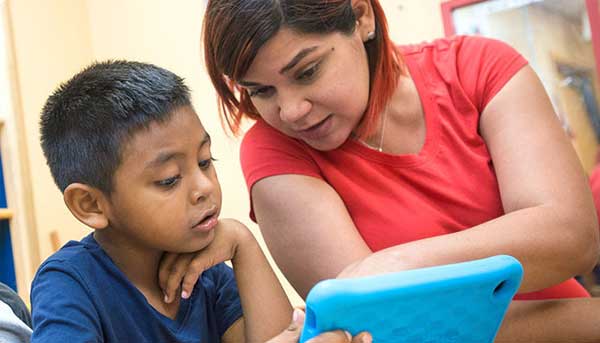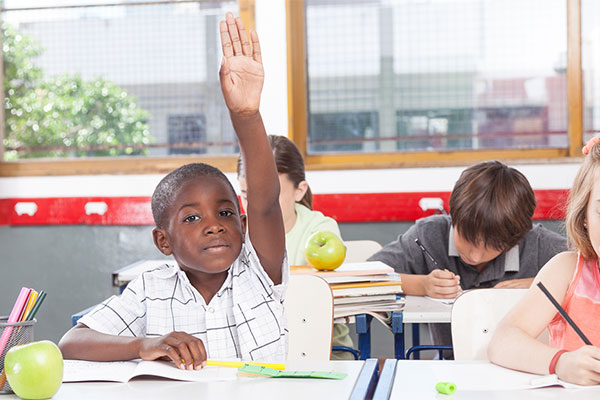April 7, 2022
Sorting through studies regarding the importance of evaluation, measurement, and assessment in education can feel overwhelming.
For many educators, administering tests can be a logistical challenge if they don’t have the right tools and a comprehensive assessment system in place. For others, the connection between daily teaching and higher student test scores feels distant—if even at all related.
In this blog, I’ll take a close look at the measurement of learning and discuss tools that can help you to best understand your students’ progress and needs. I’ll look at:
- What these tools are
- Why measurement and assessments are vital to a strong multi-tiered system of support (MTSS)
- What types of assessments you can use in your school or district

Defining the terms: Measurement and assessment
The terms “measurement” and “assessment” are often used interchangeably in education. However, while they are related, they have different meanings and purposes. Let’s explore each of these terms and their applications in more depth.
Measurement defined
When we think about measurement, we often assume it means quantifying concrete objects. For example, you may imagine a ruler or a measuring cup. In these cases, there is a physical object naming the value, the amount, or the length of something.
But this definition fails to fully define measurement in:
- Teaching
- The learning process; or
- Education
When it comes to testing students, measurement is the standard or process students are compared against. Measurement is, in other words, the “yardstick” of education.
Measurement is the quantifiable part of the testing process, and it is required to gauge the efficacy of our programs and the growth of our students. Without measurement, we do not know what to assess.
An example of measurement in education
So, how do you measure student learning? Assessments are one of the primary tools for measurement in education. We can use the results of assessments, such as standardized test scores, to measure student progress.
Other examples of measurement in education are:
- Percentile rankings
- Raw scores
- Standard scores
- Completion percentages
All of the data we can collect through assessment and evaluation allows us to measure student progress and determine student achievement levels.

Assessment defined
Assessment is a process that utilizes a variety of tools that can have both formative and summative qualities. When we assess a student, we are clearly gathering information about the student, such as the student’s knowledge or skills.
An assessment is a tool that allows us to look at the data and the student together and determine what is working and/or not working. In this way, assessments can give us a broader picture of the overall system and any areas of potential weakness.
Successful assessment systems commonly include:
- Just-in-time/short-cycle assessments
- Universal screening/benchmarking
- Skills analysis/diagnostic
- Progress monitoring
- Interim assessments
- Summative assessments
It is important to note that while testing helps to assess a student, it is not the only way students can or should be assessed. Testing is an invaluable part of a larger assessment strategy.
An example of assessment in education
Assessments can take many forms. While we may commonly think of formal, high-stakes tests when we imagine assessments, they are far from the only way to assess a student.
Some examples of assessment in education include:
- Screeners
- Classroom observations
- Interviews
- Diagnostic tests
- Concept maps
- Prompted journaling
Learning is not linear, and multi-dimensional growth is only measurable if appropriate assessments are taking place.
Insights to move learning forward
Discover assessment and instructional tools from Renaissance for pre-K–12 learners.

Understanding standards and skills: What are the types of measurement in assessment?
Comprehensive assessment systems provide structure to education. A complete system will have different types of assessments that are administered at various times to give an overall view of student progress.
Once we know what to measure, our next question becomes, what are the right assessment tools to measure learning? These tools fall under two general categories: standards assessment and skills assessment.
#1: Standards assessment
Standards are the specific, hierarchical learning goals expected of students in a particular grade, grade range, or area of study.
We can imagine standards as the road students are driving along during their academic journey. The student starts at Point A and will eventually reach Point B. Regardless of the pace or the path they take, our goal is that they arrive at the destination. And if we want to know whether a student is meeting the learning objectives, we can offer a standards assessment.
The benefits of standards assessments
Not every student learns the same way or at the same pace. A standards assessment doesn’t judge a student based on how they got to the destination, just that they arrived.
Within test measurements and evaluations, standards assessments can give an objective overview of classroom success.

Examples of standards assessments
Most basic measurements of learning include a type of standards assessment. For example, state testing is a type of standards assessment that reveals how much of what the student learned was retained. Students take the test in the spring on everything they should have learned over the course of the school year.
Standards assessments include:
- Just-in-time/short-cycle assessments (formative)
- Interim assessments
- Summative assessments
Just-in-time/short-cycle assessments
Short-cycle assessments are common in the classroom. Students across all grades and subjects are familiar with this type of assessment, even if they are unfamiliar with the name.
These formative assessments confirm that specific learning has taken place and provide data to inform future instruction. Examples of short-cycle assessments include:
- Pop quizzes
- End-of-chapter tests
- Class discussion
- Comprehension checks
Interim assessments
Interim assessments measure students’ proficiency in the standards. These tests are given periodically and can help to determine the efficacy of instruction.
Examples of interim assessments include:
- Standards-aligned common assessments
- Curriculum vendor-provided interims
- District-created interims
Summative assessments
At the end of a unit, course, or school year, grades need to be assigned to each student. Summative assessments are useful for evaluating and certifying learning. Students can demonstrate their mastery of the material and have their knowledge measured and graded.
Examples of summative assessments include:
- Standards-aligned common assessments
- State standards assessments
- Curriculum vendor-provided summative assessments
- District-created summative assessments
- Classroom summative assessments

#2: Skills assessment
Skills are the abilities students need in order to use their knowledge effectively and readily.
Let’s return to the road analogy. If standards are the road, then skills are the foundation under the road. If there are too many missing or rough pieces, navigating the road can be treacherous. In order to determine what type of foundation the student is driving on, we need to conduct a skills assessment.
The benefits of skills assessments
Assessing the methods and skills students use to reach the destination can reveal a lot. Some students may have a smooth road and an easy journey. Others may face potholes and rough terrain. If a student is facing too many obstacles, learning will clearly suffer.
A skills assessment can give insight into the student’s journey and help you to develop strategies to improve the learning process and meet the needs of each student.

Examples of skills assessments
Skills assessments can look like ordinary teaching tools, such as spelling tests or pop quizzes. Most, if not all, classrooms included some type of skills assessment activity long before regular testing was a part of the school year.
Skills assessments include:
- Universal screening/benchmarking
- Skills analysis/diagnostic
- Progress monitoring
Universal screening/benchmarking
We often need a starting point to determine how best to guide a student. Universal screening or benchmarking helps identify which students may need additional services or assistance or are at risk of falling behind.
Examples of universal screening/benchmarking include:
- FastBridge’s combined suite of reading, math, and social-emotional behavior assessments
- Star Assessments for early literacy, reading, and math, available in both English and Spanish
Skills analysis/diagnostic
A skills analysis can be used as a reporting component of the universal screening or as a follow-up for students who are flagged during the benchmark test. Skills analysis and diagnostic testing can help you to pinpoint specific learning needs or deficits.
Examples of skills analysis and diagnostic assessments include the unique Star Phonics assessment from Renaissance, which is administered to students in addition to the FastBridge or Star universal screener for reading.
Progress monitoring
For students receiving Tier 2 or Tier 3 interventions, progress monitoring is needed to measure the effectiveness of the intervention.
Progress monitoring allows you to evaluate progress toward learning goals based on the student’s rate of improvement. You can determine if the student benefits from intervention by measuring their advancement in specific skills.
Examples of progress monitoring include FastBridge’s FAST Projection line and the Progress Monitoring Report in Star Assessments.

The importance of assessment, measurement, evaluation, and testing
Measurement and assessment are keys to making sure we are serving students well. Without them, we have no way of knowing what we are doing or why. Using assessments and measurements to gauge the success of students, instruction, and school and district initiatives can also help us to continue to improve the learning process.
Standards exist to measure a student’s proficiency in their grade level. We can use assessments to determine whether a student meets the standards for their grade or subject. A skills assessment helps identify skills the student might be missing and gives us a closer look at their educational needs.
We can use these tools as part of a comprehensive assessment system to provide students with a stronger foundation. Assessments give us answers to questions like:
- What do students know?
- Where are students struggling?
- Why are they struggling?
- What should I teach next?
- What adjustments can I make to future lessons?
- Which students need academic intervention?
- Which interventions best match the student’s needs?
- Does the student’s retained learning meet district and state standards?
- Are there gaps in the curriculum between expectations and assessment?
When we complete the assessments and measure the outcomes, we can create an effective and efficient plan to improve the rate of success among our students.
Are we testing too much?
Not all tests are created equal. As noted earlier, each test is going to have a different purpose and give us specific information. And remember, while all tests are assessments, not all assessments are formal tests.
We hear the terms over and over: measurement, assessment, and evaluation. It can be overwhelming, and it feels that we must ask: Are we testing too much?
The short answer is “no.” We want to enable students to learn and ensure they meet state standards. To do that, we need assessments to show us where we are succeeding and where we can evaluate and improve. It is not feasible to know if a student can learn and retain information without assessing their skills and abilities.
Assessments also help us to identify problems before they become insurmountable. It is in the best interest of the student to be assessed so we can recognize how to give them the support they need.

Renaissance: Turning measurement and assessment data into actionable insights
You can’t create the best learning plan for your students with only a couple of pieces of data, just like you can’t see the whole picture if you’re only holding one piece of the puzzle. If you already have a system, Renaissance can help you to strengthen your assessment plan and give you the rest of the pieces to the puzzle.
We provide comprehensive assessment, MTSS collaboration and management, and real-time dashboard tools for data-driven decision making. With our tools, you can:
- Visualize each student’s progress
- Determine the right instructional or intervention strategy; and
- Take the best next action, moment-by-moment
No more guessing or doing what you’ve always done. We give you a road map to success.
Learn more
Connect with an expert to learn more about Renaissance assessments and instructional solutions built for today’s classrooms.

